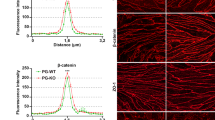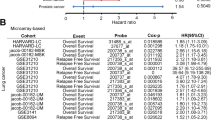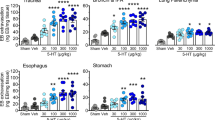Abstract
Aim:
TRPV4-C1 heteromeric channels contribute to store-operated Ca2+ entry in vascular endothelial cells. However, the negative regulation of these channels is not fully understood. This study was conducted to investigate the inhibitory effect of PKG1α on TRPV4-C1 heteromeric channels.
Methods:
Immuno-fluorescence resonance energy transfer (FRET) was used to explore the spatial proximity of PKG1α and TRPC1. Phosphorylation of endogenous TRPC1 was tested by phosphorylation assay. [Ca2+]i transients and cation current in MAECs were assessed with Fura-2 fluorescence and whole-cell recording, respectively. In addition, rat mesenteric arteries segments were prepared, and vascular relaxation was examined with wire myography.
Results:
In immuno-FRET experiments, after exposure of these cells to 8-Br-cGMP, more PKG1α was observed in the plasma membrane, and PKG1α and TRPC1 were observed to be in closer proximity. TAT-TRPC1S172 and TAT-TRPC1T313 peptide fragments, which contain the PKG targeted residues Ser172 and Thr313, respectively, were introduced into isolated endothelial cells to abrogate the translocation of PKG1α. Furthermore, a phosphorylation assay demonstrated that PKG directly phosphorylates TRPC1 at Ser172 and Thr313 in endothelial cells. In addition, PKG activator 8-Br-cGMP markedly reduced the magnitude of the 4αPDD-induced and 11,12-EET-induced [Ca2+]i transients, the cation current and vascular relaxation.
Conclusion:
This study uncovers a novel mechanism by which PKG negatively regulates endothelial heteromeric TRPV4-C1 channels through increasing the spatial proximity of TRPV4-C1 to PKG1α via translocation and through phosphorylating Ser172 and Thr313 of TRPC1.
Similar content being viewed by others
Log in or create a free account to read this content
Gain free access to this article, as well as selected content from this journal and more on nature.com
or
References
Kwan HY, Huang Y, Yao X . Store-operated calcium entry in vascular endothelial cells is inhibited by cGMP via a protein kinase G-dependent mechanism. J Biol Chem 2000; 275: 6758–63.
Parekh AB, Penner R . Store depletion and calcium influx. Physiol Rev 1997; 77: 901–30.
Pasyk E, Inazu M, Daniel EE . Cpa enhances Ca2+ entry in cultured bovine pulmonary arterial endothelial cells in an IP3-independent manner. Am J Physiol 1995; 268: H138–146.
Sharma NR, Davis MJ . Calcium entry activated by store depletion in coronary endothelium is promoted by tyrosine phosphorylation. Am J Physiol 1996; 270: H267–274.
Vaca L, Kunze DL . Depletion of intracellular Ca2+ stores activates a Ca2+-selective channel in vascular endothelium. Am J Physiol 1994; 267: C920–925.
Yao X, Kwan HY, Chan FL, Chan NW, Huang Y . A protein kinase G-sensitive channel mediates flow-induced Ca2+ entry into vascular endothelial cells. FASEB J 2000; 14: 932–8.
Ma X, Qiu S, Luo J, Ma Y, Ngai CY, Shen B, et al. Functional role of vanilloid transient receptor potential 4-canonical transient receptor potential 1 complex in flow-induced Ca2+ influx. Arterioscler Thromb Vasc Biol 2010; 30: 851–8.
Ma X, Cheng KT, Wong CO, O'Neil RG, Birnbaumer L, Ambudkar IS, et al. Heteromeric TRPV4-C1 channels contribute to store-operated Ca2+ entry in vascular endothelial cells. Cell Calcium 2011; 50: 502–9.
Voets T, Prenen J, Vriens J, Watanabe H, Janssens A, Wissenbach U, et al. Molecular determinants of permeation through the cation channel TRPV4. J Biol Chem 2002; 277: 33704–10.
Schwarze SR, Ho A, Vocero-Akbani A, Dowdy SF . In vivo protein transduction: delivery of a biologically active protein into the mouse. Science 1999; 285: 1569–72.
Zhang P, Ma Y, Wang Y, Ma X, Huang Y, Ronald A, et al. Nitric oxide and protein kinase G act on TRPC1 to inhibit 11,12-EET-induced vascular relaxation. Cardiovasc Res 2014; 104: 138–46.
Kalabis J, Rosenberg I, Podolsky DK . Vangl1 protein acts as a downstream effector of intestinal trefoil factor (ITF)/TFF3 signaling and regulates wound healing of intestinal epithelium. J Biol Chem 2006; 281: 6434–41.
Xia Z, Liu Y . Reliable and global measurement of fluorescence resonance energy transfer using fluorescence microscopes. Biophys J 2010; 81: 2395–402.
Adebiyi A, Zhao G, Narayanan D, Thomas-Gatewood CM, Bannister JP, Jaggar JH . Isoform-selective physical coupling of TRPC3 channels to IP3 receptors in smooth muscle cells regulates arterial contractility. Circ Res 2010; 106: 1603–12.
Koitabashi N, Aiba T, Hesketh GG, Rowell J, Zhang M, Takimoto E, et al. Cyclic GMP/PKG-dependent inhibition of TRPC6 channel activity and expression negatively regulates cardiomyocyte NFAT activation novel mechanism of cardiac stress modulation by PDE5 inhibition. J Mol Cell Cardiol 2010; 48: 713–24.
Kwan HY, Huang Y, Yao X . Regulation of canonical transient receptor potential isoform 3 (TRPC3) channel by protein kinase G. Proc Natl Acad Sci U S A 2004; 101: 2625–30.
Schwarze SR, Ho A, Vocero-Akbani A, Dowdy SF . In vivo protein transduction: Delivery of a biologically active protein into the mouse. Science 1999; 285: 1569–1572
Watanabe H, Davis JB, Smart D, Jerman JC, Smith GD, Hayes P, et al. Activation of TRPV4 channels (HVRl-2/MTRP12) by phorbol derivatives. J Biol Chem 2002; 277: 13569–77.
Ma X, Cao J, Luo J, Nilius B, Huang Y, Ambudkar IS, et al. Depletion of intracellular Ca2+ stores stimulates the translocation of vanilloid transient receptor potential 4-C1 heteromeric channels to the plasma membrane. Arterioscler Thromb Vasc Biol 2010; 30: 2249–55.
Feletou M, Vanhoutte PM . EDHF: an update. Clin Sci 2009; 117: 139–155.
Sonkusare SK, Bonev AD, Ledoux J, Liedtke W, Kotlikoff MI, Heppner TJ, et al. Elementary Ca2+ signals through endothelial TRPV4 channels regulate vascular function. Science 2012; 336: 597–601.
Ma Y, Zhang P, Li J, Lu J, Ge J, Zhao Z, et al. Epoxyeicosatrienoic acids act through TRPV4-TRPC1-KCa1.1 complex to induce smooth muscle membrane hyperpolarization and relaxation in human internal mammary arteries. BBA-Mol Basic Dis 2015; 1852: 552–9.
Acknowledgements
We thank Prof IC BRUCE for critical reading of the manuscript. This work was supported by National Natural Science Foundation of China (91439131 and 81572940 to Xin MA), (21305051 to Chun-lei TANG); the National High-Technology Research and Development Program (863 Program) of China (2015AA020948 to Xin MA); the Natural Science Foundation for Distinguished Young Scholars of Jiangsu Province BK20140004 (to Xin MA); the Program for New Century Excellent Talents in University of Ministry of Education of China NCET-12-0880 (to Xin MA).
Author information
Authors and Affiliations
Corresponding author
Rights and permissions
About this article
Cite this article
Zhang, P., Mao, Aq., Sun, Cy. et al. Translocation of PKG1α acts on TRPV4-C1 heteromeric channels to inhibit endothelial Ca2+ entry. Acta Pharmacol Sin 37, 1199–1207 (2016). https://doi.org/10.1038/aps.2016.43
Received:
Accepted:
Published:
Issue date:
DOI: https://doi.org/10.1038/aps.2016.43
Keywords
This article is cited by
-
TRPC5-induced autophagy promotes drug resistance in breast carcinoma via CaMKKβ/AMPKα/mTOR pathway
Scientific Reports (2017)



